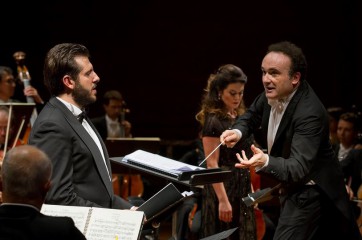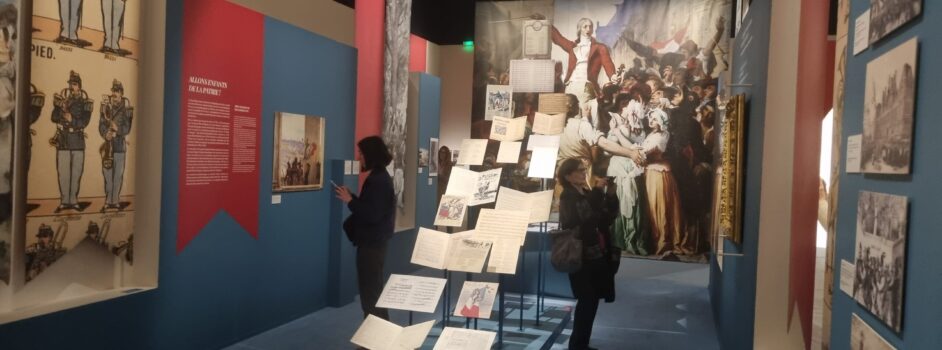Plus de détails
Genève, Victoria Hall, 10-X-2013. Ernest Reyer (1823-1909) : Sigurd (version de concert). Opéra en 4 actes et 9 tableaux d’Ernest Reyer, livret de Camille du Locle et Alfred Blau. Créé le 7 janvier 1884 à Bruxelles, au Théâtre de la Monnaie. Andrea Carè (Sigurd), Anna Caterina Antonacci (Brunhilde), Boris Pinkhasovich (Gunther), Tijl Faveyts (Hagen), Anne Sophie Duprels (Hilda), Marie-Ange Todorovitch (Uta), Khachik Matevosyan (un prêtre d’Odin), Nicolas Courjal (un barde), Nicolas Carré (Rudiger). Orchestre de la Suisse Romande, Chœur du Grand Théâtre de Genève ; Ching-Lien Wu, chef du chœur ; Frédéric Chaslin, direction.
 Genevans had not heard Ernest Reyer's Sigurd for a century, since its last performance was during the 1911–2 season. It has often been described as a matching piece to Wagner's Twilight of the Gods, because of the many similarities between their respective libretti (both are taken from the Nibelungen epic, Sigurd‘s being more centered on the Edda) as well as their lengths (four hours of music). Yet, when he started working on it in 1862 (he would finish it only in 1883), Reyer knew nothing but Tannhäuser and Lohengrin, and was still unaware of the use of leitmotivs that Wagner would develop in his Tetralogy. He said himself that he was paying homage to Gluck (Iphigénie en Tauride or Armide) and to Weber (Euryanthe or the Wolf's Glen scene in Der Freischütz), while being admirative of Wagner and Berlioz. Indeed, the first immediately perceptible influence would rather be that of Berlioz: a lavish orchestration, with about thirty motifs subtly combined; a picturesque use of colours; the highlighting of the winds; the rich melodic lines, characteristic of the French tradition; the chorus used as a proper character… All this is strongly reminiscent of the great symphonic works of Berlioz, but also of his operas, such as Les Troyens. Each scene begins with orchestral descriptions suggesting scenes or landscapes poetic as well as dramatic. The bold and unusual harmonic sequences (here, Wagnerian influences can be recognised more clearly), punctuated with fast changes of tone and atmosphere, are really prodigious, just as the brutal suspension of the chorus for a symphonic episode.
Genevans had not heard Ernest Reyer's Sigurd for a century, since its last performance was during the 1911–2 season. It has often been described as a matching piece to Wagner's Twilight of the Gods, because of the many similarities between their respective libretti (both are taken from the Nibelungen epic, Sigurd‘s being more centered on the Edda) as well as their lengths (four hours of music). Yet, when he started working on it in 1862 (he would finish it only in 1883), Reyer knew nothing but Tannhäuser and Lohengrin, and was still unaware of the use of leitmotivs that Wagner would develop in his Tetralogy. He said himself that he was paying homage to Gluck (Iphigénie en Tauride or Armide) and to Weber (Euryanthe or the Wolf's Glen scene in Der Freischütz), while being admirative of Wagner and Berlioz. Indeed, the first immediately perceptible influence would rather be that of Berlioz: a lavish orchestration, with about thirty motifs subtly combined; a picturesque use of colours; the highlighting of the winds; the rich melodic lines, characteristic of the French tradition; the chorus used as a proper character… All this is strongly reminiscent of the great symphonic works of Berlioz, but also of his operas, such as Les Troyens. Each scene begins with orchestral descriptions suggesting scenes or landscapes poetic as well as dramatic. The bold and unusual harmonic sequences (here, Wagnerian influences can be recognised more clearly), punctuated with fast changes of tone and atmosphere, are really prodigious, just as the brutal suspension of the chorus for a symphonic episode.
Several voices stand out on this sound fabric. First of all comes mezzo Marie-Ange Todorovitch, who plays Uta, Hilda's nurse. Along with Anne Sophei Duprels as Hilda (Gunther's sister), she has to open and close the opera. The spectator is soon reassured by her rich voice and her implication (commitment?) in the part, which are enough in our eyes to herald the success of the representation. The score forces soprano Duprels to sing in a rather low register as well, hindering her voice from being fully projected, but her high notes match well the hope and despair of her character. Anna Caterina Antonacci as Brunhild is passionate, tender and strong at the same time. She goes through all sorts of feelings while singing the tunes “Salut! Splendeur du jour!” from Act II and “Ô palais radieux” from Act IV, but always with the right tones.
Italian tenor Andrea Carè plays the titular character, and his vocal clarity matches well Antonacci's thick tone; near the end, they have a remarkable duet “Oublions les maux soufferts,” in a Verdian flight. While his French is clearly understandable, the same thing cannot be said of Boris Pikhasovich (Gunther), whose diction is often ambiguous and approximate. His baryton voice becomes sometimes dull, despite its depth, because of his inexpressive face and gestures. It is the same with Tijl Faveyts as Hagen, or even more, since his voice has a tendency to glide over some notes.
 French conductor Frédéric Chaslin, who has made some cuts to bring the opera under the three-hour mark (since its premiere, it has always been cut in some way), emphasises the orchestral and choral colors, with a certain success. The chorus, arranged at the back of the scene up to the first gallery, has enough character to be a second orchestra, and with the excellent acoustics of this mythic place, it adds a lot to the overall sound.
French conductor Frédéric Chaslin, who has made some cuts to bring the opera under the three-hour mark (since its premiere, it has always been cut in some way), emphasises the orchestral and choral colors, with a certain success. The chorus, arranged at the back of the scene up to the first gallery, has enough character to be a second orchestra, and with the excellent acoustics of this mythic place, it adds a lot to the overall sound.
Such a powerful representation makes us eager to see a complete production.
Photos : Andrea Carè and Anne Sophie Duprels ; Andrea Carè, Anna Caterina Antonacci and Frédéric Chaslin © GTG/Vincent Lepresle
Plus de détails
Genève, Victoria Hall, 10-X-2013. Ernest Reyer (1823-1909) : Sigurd (version de concert). Opéra en 4 actes et 9 tableaux d’Ernest Reyer, livret de Camille du Locle et Alfred Blau. Créé le 7 janvier 1884 à Bruxelles, au Théâtre de la Monnaie. Andrea Carè (Sigurd), Anna Caterina Antonacci (Brunhilde), Boris Pinkhasovich (Gunther), Tijl Faveyts (Hagen), Anne Sophie Duprels (Hilda), Marie-Ange Todorovitch (Uta), Khachik Matevosyan (un prêtre d’Odin), Nicolas Courjal (un barde), Nicolas Carré (Rudiger). Orchestre de la Suisse Romande, Chœur du Grand Théâtre de Genève ; Ching-Lien Wu, chef du chœur ; Frédéric Chaslin, direction.







